A complete guide to Chinese hand-pulled noodles. Techniques explained in detail and two shapes introduced. Following this recipe, everyone can make them with ease!
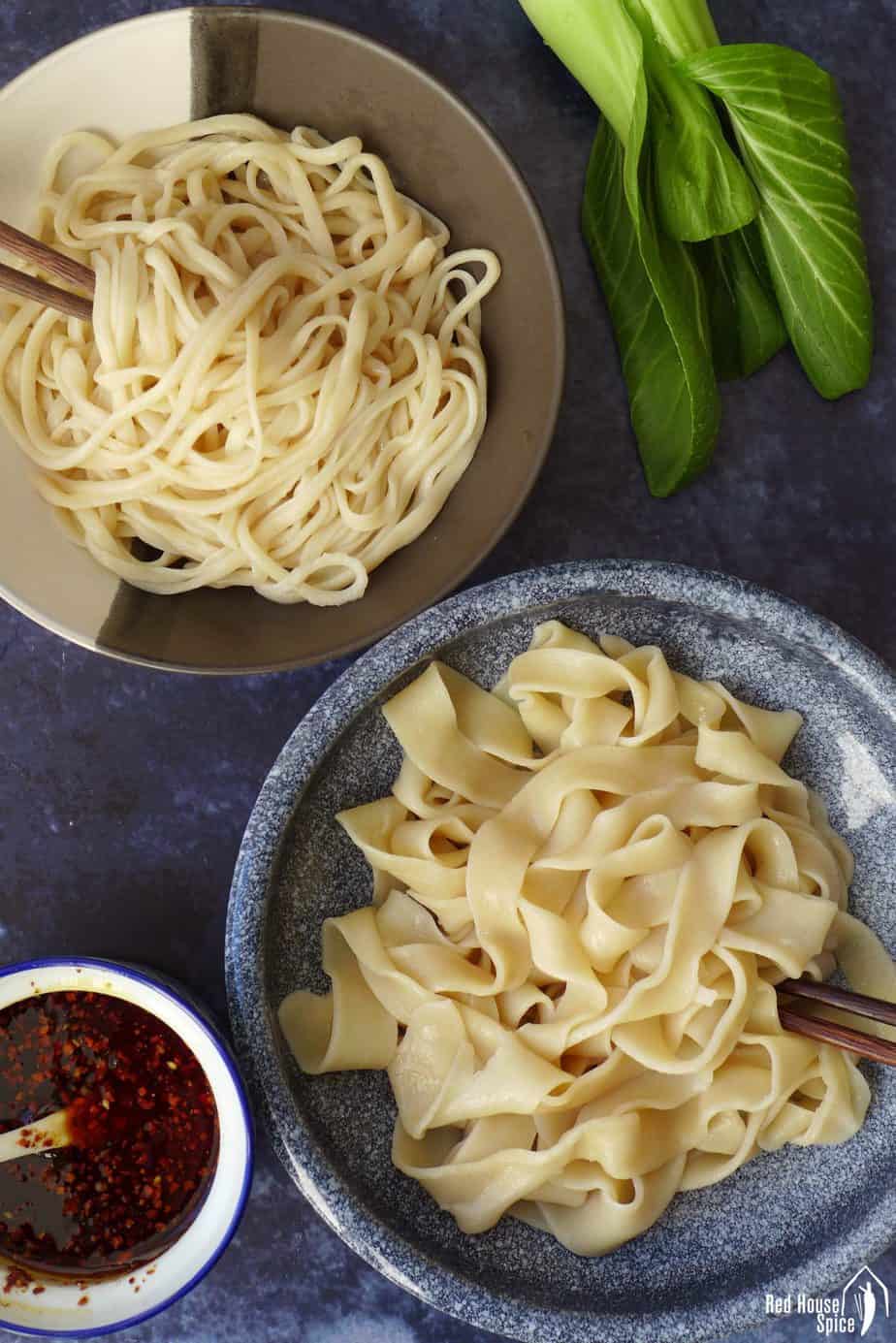
Hand-pulled noodles, known as Lā Miàn/拉面, Lā Tiáo Zi/拉条子 or Chě Miàn/扯面, is a recipe that I’ve been meaning to share for a long time. Growing up in Gansu province, China where it’s a common dish in restaurants and households, I learned the technique through observing my parents’ cooking. I enjoy the pleasure of both making and eating them.
What are hand-pulled noodles
As its name suggests, hand-pulled noodles are formed by pulling wheat flour dough by hand into long, elastic strips. Compared to hand-cut and machine-made noodles, they usually have a more silky, springy and chewy texture. They are always served super fresh as the pulling and cooking process happens at the same time.
What are they made of?
Hand-pulled noodles contain three basic ingredients: wheat flour, salt and water. In some cases, an alkaline agent is added to the dough to make the noodles more springy.
Two types of hand-pulled noodles
The professional version
One serving of noodles are pulled from one single piece of dough by folding multiple times. Lanzhou Beef Noodle Soup/兰州牛肉面 (aka Lanzhou Lā Miàn, 兰州拉面), the classic dish of my hometown, showcases this amazing culinary art of noodle making. The use of an alkaline agent (Péng Huī/蓬灰 in this case) makes the dough super flexible and stretchy.
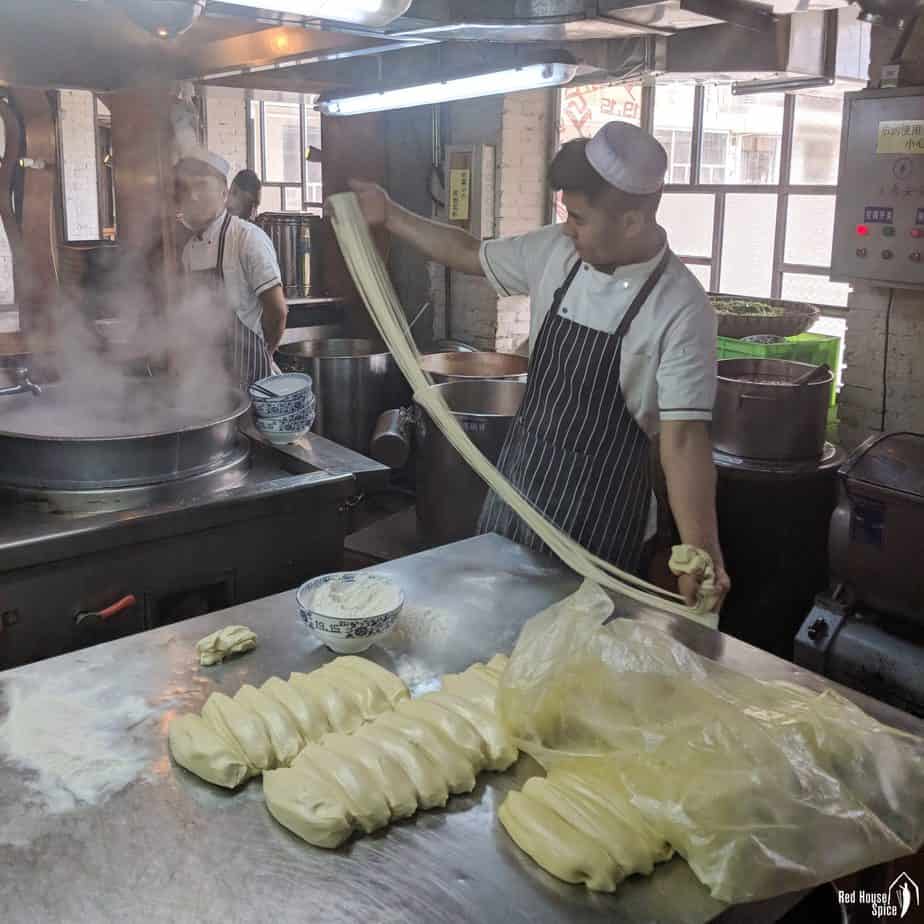
If you haven’t seen how they are made, I suggest you take a look at a noodle pulling video I took on one of my Culinary Tours of China. My tour participants were very lucky to have the chance to visit the back kitchen and communicate with the chefs. On my next tours, we will go one step further to put our hands on the dough and learn from professional noodle masters.
The easy home version
My recipe introduces another type of hand-pulled noodles: the dough is firstly cut into strips then pulled one by one into long noodles. The popular Xi’an Biang Biang Noodles are made this way.
Compared to the professional method, this technique is much easier to master. Although simple to make, I’d like to explain in detail every aspect of this dish. I hope my complete guide will help you, including kitchen novices, to have a fail-proof experience learning this cooking skill.

The basic workflow
Before we get down to the detailed explanations, let me first outline the procedures for making hand-pulled noodles.
- Make a smooth, fairly firm dough using flour, salt & water.
- Divide then flatten the dough. Coat with oil then leave to rest.
- Bring a pot of water to boil. Cut the dough pieces into strips.
- Pull the strips into long noodles one at a time. Drop into the water.
- Cook for 1-2 minutes then dish out.
How to make the perfect dough
The dough for hand-pulled noodles involves three basic ingredients: wheat flour, water and a little salt. The finished dough should be soft, smooth and elastic thus can be easily pulled into the desired shapes without breaking. Paying attention to the following rules, everyone can make perfect dough with ease.
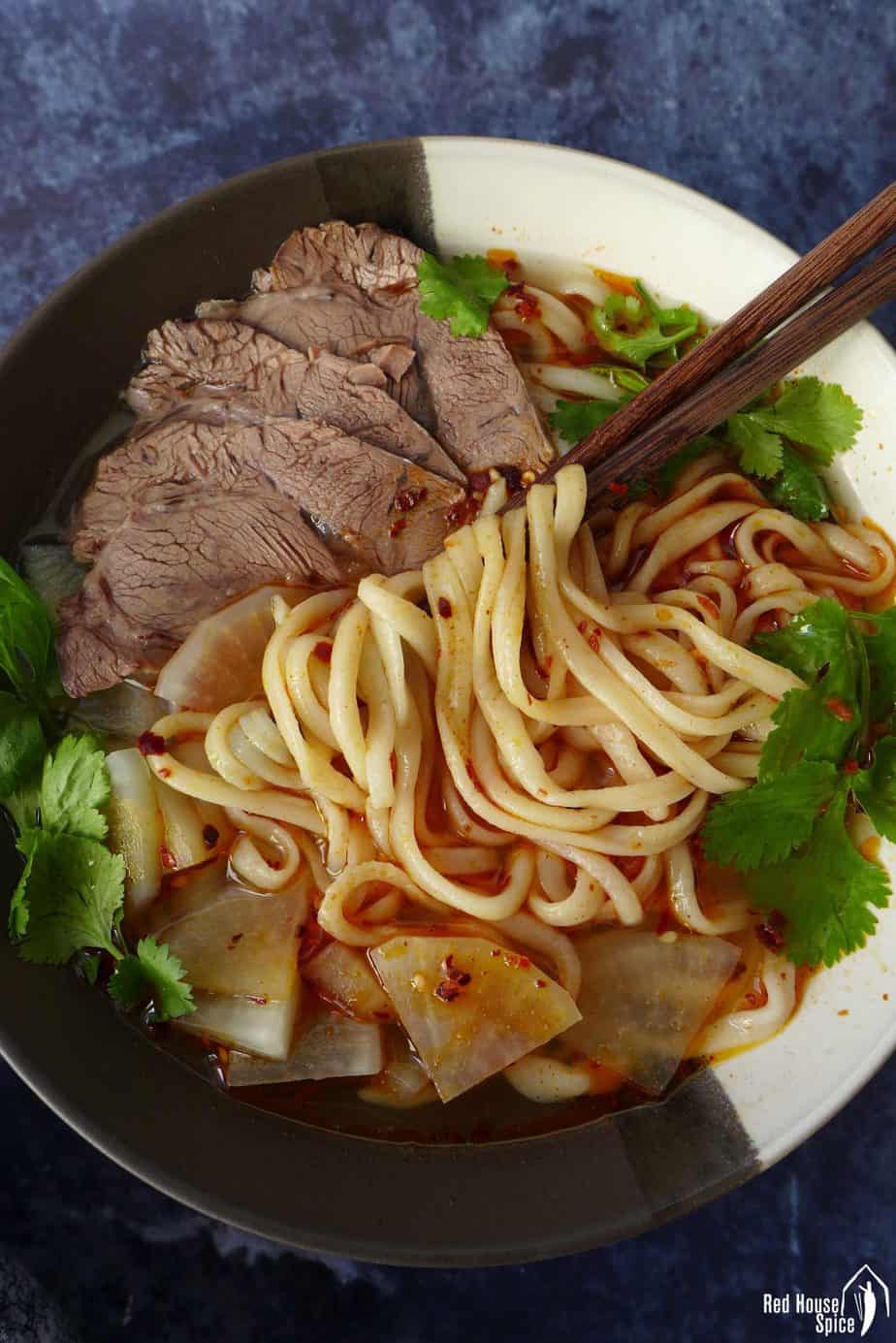
Use all-purpose flour with medium gluten
Flour with a medium level of gluten works the best for hand-pulled noodles. That is to say that the protein content should be 10-11g per 100g flour. All-purpose flour (aka plain white flour) sold in the US and the UK falls into this range.
However, the gluten level of all-purpose flour varies among countries. Check the nutrition label on the package to learn the protein content.
Flour high in gluten (above 13g protein per 100g flour), such as very strong bread flour, can be used for this recipe but it’s harder to work on. Due to its strong, super elastic gluten, the dough tends to shrink back and breaks more easily when pulled.
NB: Wholemeal flour/gluten-free flour is not suitable for making hand-pulled noodles.
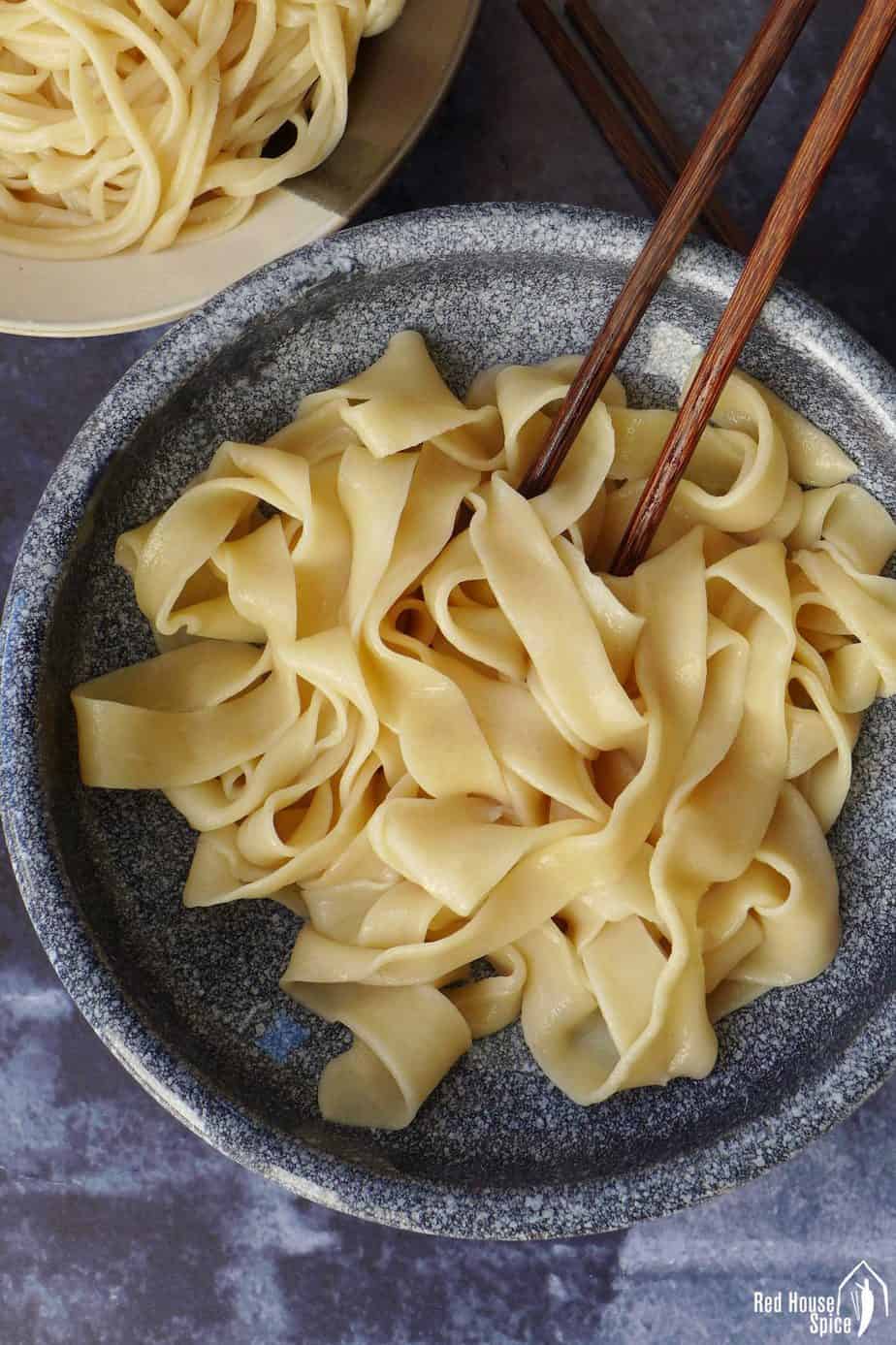
The flour-water ratio is 2:1 by weight
To ensure a fail-proof experience, I recommend you measure flour by weight as it’s much more accurate than measuring with a cup.
The flour-water ratio is 2:1 by weight. In my recipe, I add 125g/ml water to 250g flour to make a dough for 2 servings.
You might need to slightly adjust the water volume as flour of different brands absorbs water differently. The initial dough (before resting) should be smooth but quite firm. You wouldn’t need to dust the work surface with flour when kneading/rolling.
Add a little salt to the dough
Just like my parents always do, I add a little salt to the dough for hand-pulled noodles. This is to make cooked noodles more “Jīn Dào, 筋道” meaning “Al Dente”.
In “On Food and Cooking”, scientist Harold Mcgee explains the purpose of adding salt to noodles: “It tightens the gluten network and stabilizes the starch granules, keeping them intact even as they absorb water and swell.”
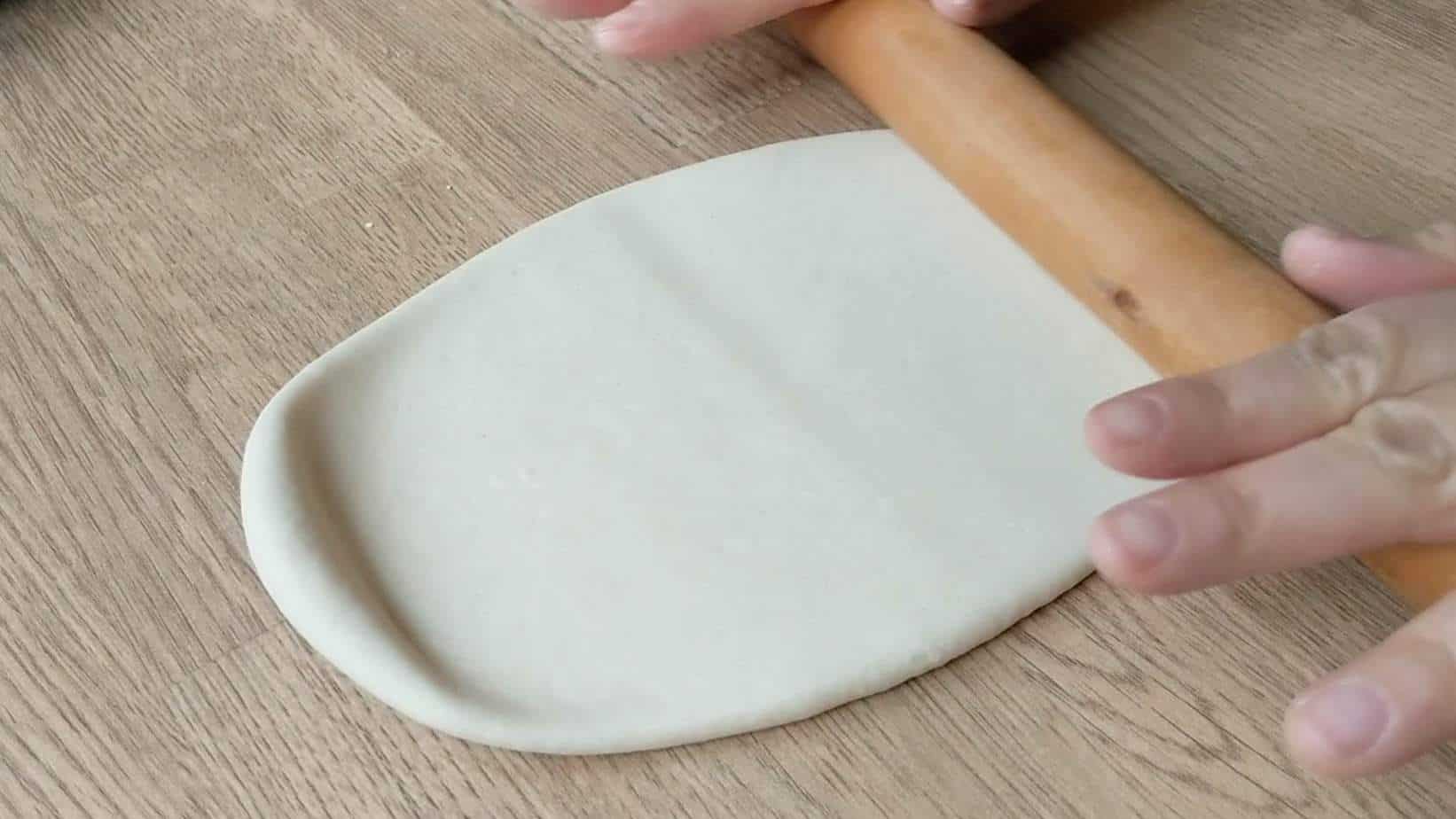
Coat the dough with oil thoroughly
After the dough has been formed, you need to do the following before leaving it to rest:
- Cut the dough into sections. If you are making 2 servings, then cut it into two pieces.
- With a rolling pin, flatten each piece to about ½ cm in thickness.
- Coat each piece with cooking oil thoroughly (both sides). Place them one on top of another in a tray. Cover with clingfilm.
Coating with oil is a crucial procedure. It prevents the dough pieces from sticking to each other. It also helps the final noodles to gain a smooth, silky look.
Some people coat the dough with flour instead. This also works but the cooked noodles tend to have a rougher appearance and a stickier texture on the surface.
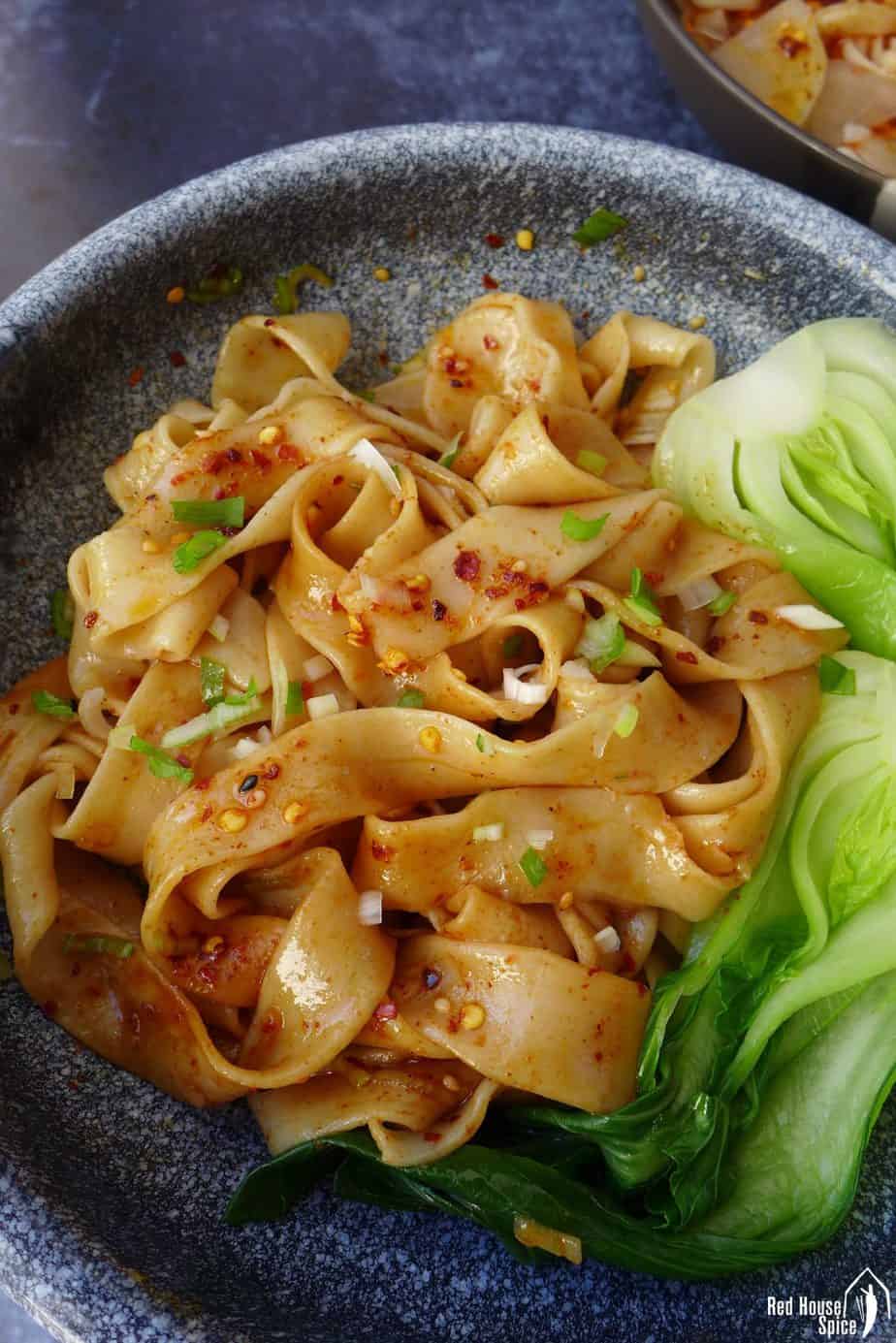
Allow enough time to rest the dough
When it comes to dough preparation, resting is very important and can not be skipped. As I mentioned above, the initially formed dough is quite firm. Over time, the elasticity of the dough relaxes. It becomes softer and more malleable. This process makes noodle pulling so much easier!
I recommend you rest the flattened dough pieces for at least 1.5 hours. If you prepare the dough in advance and pull it the next day, you can store it in the fridge. But, remember to allow it to come back to room temperature before you start working on it.
How to pull the noodles
Here comes the most exciting part (probably the most intimidating too): Pull the noodles with your hands. Unlike the master chefs in Lanzhou beef noodle restaurants, Chinese home cooks, like my parents, pull their noodles one strip at a time. My foolproof recipe uses the same method.
First of all, you need to cut the flattened dough pieces into strips. Be gentle when you transfer them onto the work surface as they’ve become very soft after resting. Try to retain their shape and do not pinch or pull (yet!).
Round or flat? Choose the noodle size
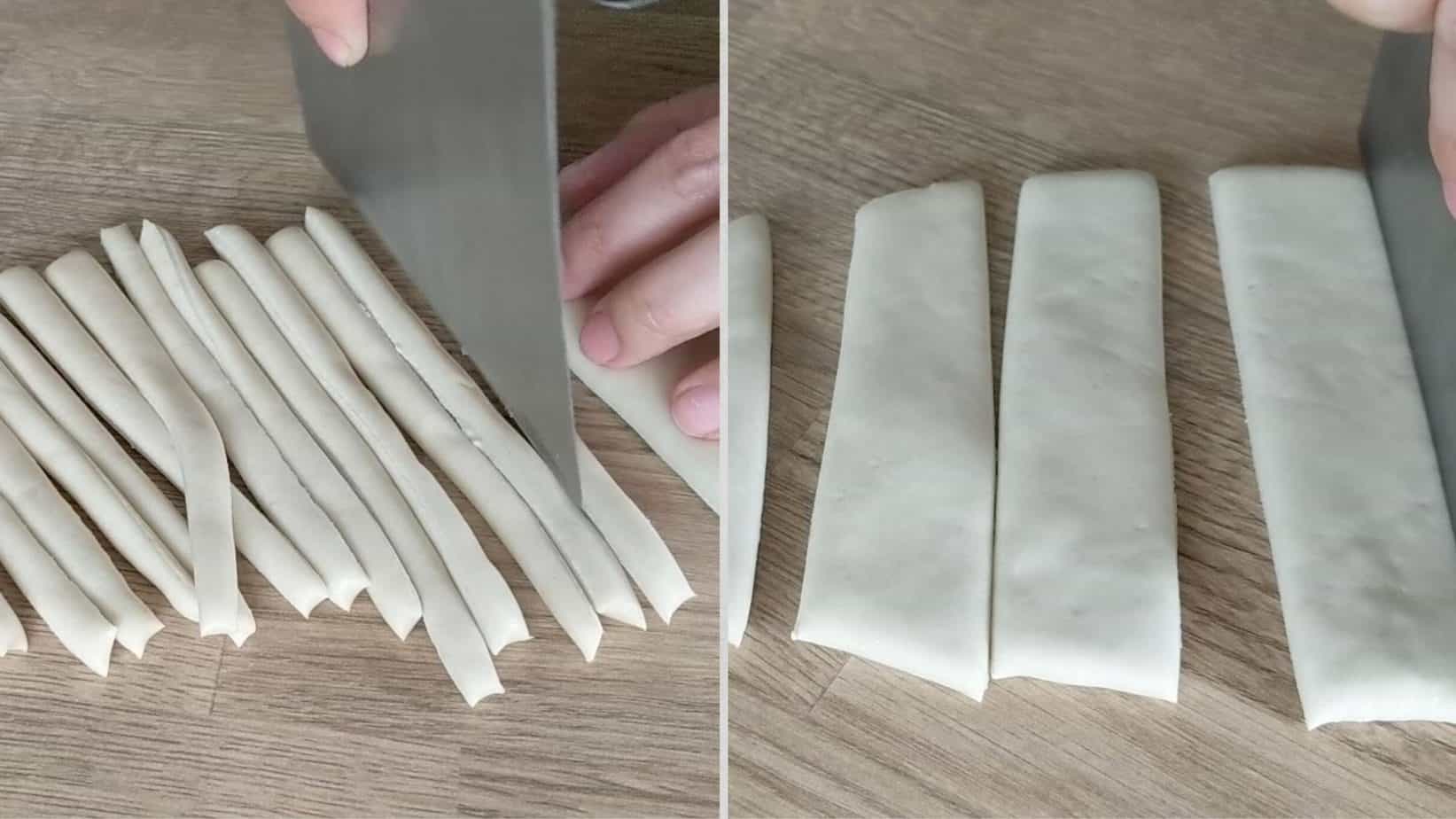
Do you have a preference for the shape of the noodles? Round, thin ones or flat wide ones? I love both. So my recipe includes two ways of shaping the noodles. Give both a try to see what works and tastes better for you.
- Round, thin noodles: Cut the flatten dough into thin strips, about 1 cm wide.
- Flat, wide noodles: Cut the flatten dough into wide strips, about 3 cm wide.
Noodle pulling technique
- Pick up one strip of dough by holding each end gently.
- Pull towards opposite directions. The movement should be smooth and consistent..
- As your arms move apart, bounce the noodle against the worktop to help it stretch further. Fold the noodle and repeat the movement.
Please check out my tutorial video (above in the post & below in the recipe card)to see exactly how I do it.
An alternative method
If you find the technique above difficult to master, try the alternative method: Over a pot of boiling water, hold one end of a strip of dough and pull the other end towards the water. Drop the pulled part into the water and continue pulling the remaining part (Please refer to the video).
How to cook the noodles
Compared to other types of noodles, the dough for hand-pulled noodles has a very high water content thus it’s very soft, easy to stick and can be cooked through fairly quickly. When cooking them, you need to take this characteristic into account. Here are some general rules to follow:
Cook one serving at a time
Pulling and cooking happen at the same time. Drop one pulled noodle straight into the boiling water then work on the next one. Stop when you finish all the dough strips for one serving.
Do not overcook
It takes quite a short time to cook hand-pulled noodles. If making round, narrow ones, leave to cook for 1 minute. If making flat, wide ones, leave to cook for 2 minutes. Do not overcook. Perfectly cooked noodles should be smooth, silky in appearance and quite chewy in texture.
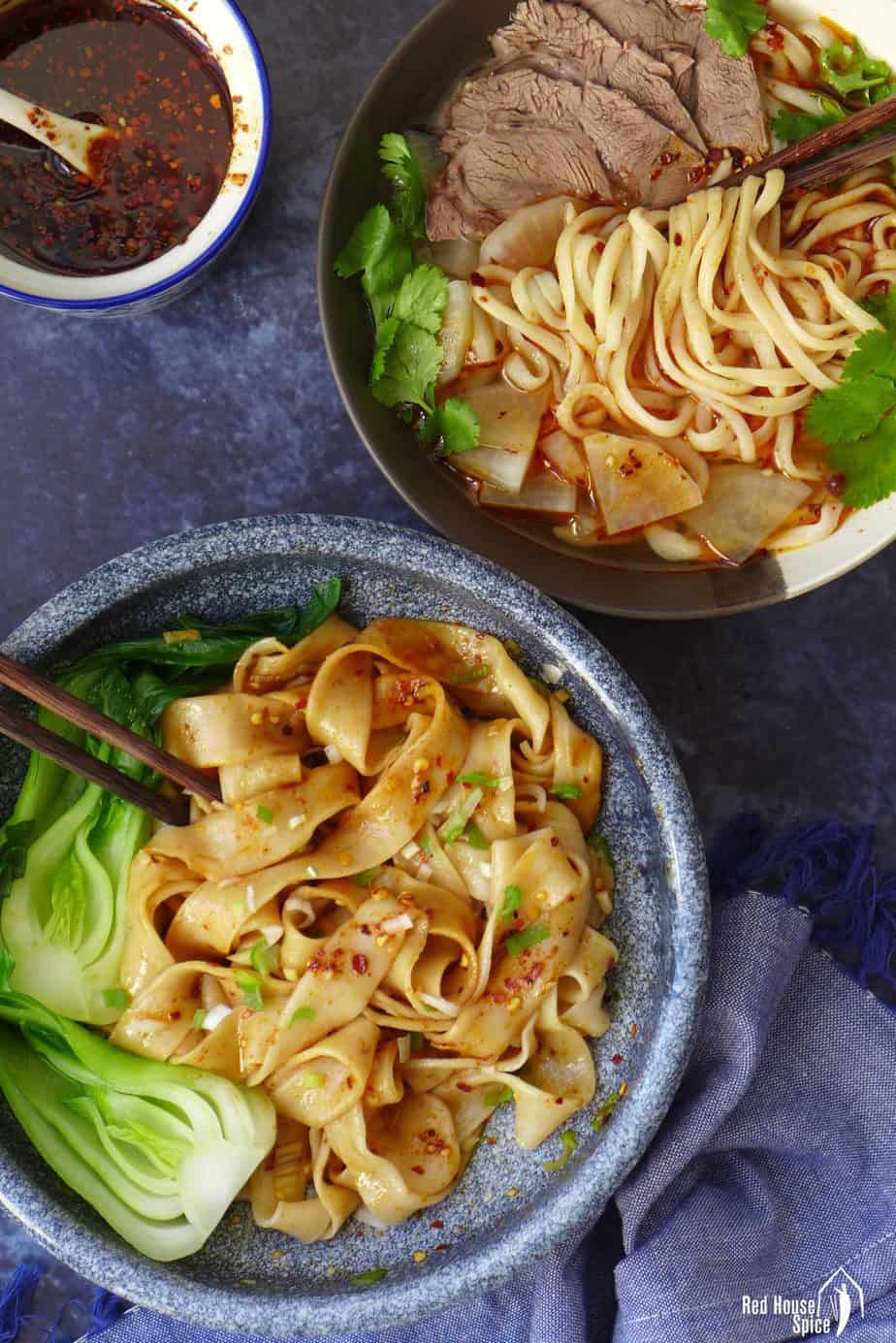
Serving ideas
Now let’s talk about how to serve your beautifully made noodles. Here are some inspirations:
- Add delicious broth/soup along with cooked meat, blanched vegetables, etc. For example, the classic Lanzhou Beef Noodle Soup; Sichuan Style Spicy Beef Noodles Soup; Chicken Meatball Noodles Soup
- Mix with saucy toppings, such as the Beijing signature noodle dish Zha Jiang Mian; Classic street foods: Dan Dan Noodles, Chongqing Noodles
- Spicy them up with a scrumptious dressing. For example, Xi’an’s popular dish Biang Biang Noodles, Classic Shanghai delicacy Scallion Oil Noodles
- Mix with stir-fry dishes of your choice. Try the following: Tomato & Egg Stir-fry; Black Pepper Beef; Sichuan Shredded Pork with Garlic Sauce
Other homemade noodle recipes
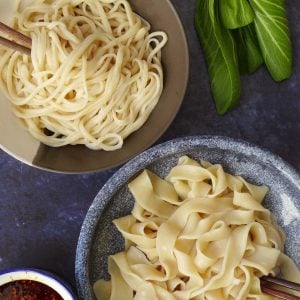
Hand-pulled noodles (La Mian), a foolproof recipe
Ingredients
- 250 g all-purpose flour - about 2 cups (see note 1)
- ¼ teaspoon salt
- 125 ml water - ½ cup + 1 teaspoon
- cooking oil - for coating the dough
Instructions
Prepare the dough
- IF KNEADING BY HAND: Mix flour and salt. Add water gradually. Mix with chopsticks/spatula until no more loose flour can be seen. Combine and knead briefly into a dough. Leave to rest for 10-15 minutes (covered). Knead again for about 2 minutes until very smooth.
- IF KNEADING WITH A STAND MIXER: Add flour, salt and water into the mixing bowl. Knead on low speed until a very smooth dough forms.
Coat & rest the dough
- Divide the dough into two equal parts. With a rolling pin, flatten each piece into a rectangle shape (about ½ cm thick).
- Thoroughly coat each piece with oil then place them on a tray. Cover with cling film then leave to rest for 1.5 hours.
Cut the dough
- Bring a large pot of water to a full boil. While waiting, cut the dough.
- Place one piece of dough on a chopping board. Widthways, cut it into strips: about 1 cm wide if making round, thin noodles; about 3 cm wide if making flat, wide noodles.
Pull the noodles (see note 3 for alternative method)
- Pick up one strip of dough by holding each end gently. Pull towards opposite directions. The movement should be smooth and consistent.
- As your arms move apart, bounce the noodle against the worktop to help it stretch further.
- Fold the noodle and repeat the movement (Please refer to the video below).
Cook the noodles
- Drop the pulled noodle into boiling water. Repeat the procedure to pull other strips cut from the first piece of dough.
- Cook 1 minute for the thin noodles or 2 minutes for the wide noodles (While waiting, cut the second piece of dough into strips.). Transfer the noodles to a serving bowl using a pair of chopsticks.
- Repeat to pull and cook the second bowl of noodles.
Serve the noodles
- To avoid the noodles sticking to each other, serve immediately.
- You may add a broth or mix the noodles with toppings/dressings. Please see note 4 for recipe links.
Store & Reheat
- If not serving straight away, you need to briefly rinse the noodles with cold water then add a few drops of sesame oil and stir well. Keep in the fridge for up to 2 days.
- To reheat: Bring a pot of water to a full boil. Add the noodles and cook for no more than 30 seconds.
Video
NOTES
NUTRITION
NUTRITION DISCLOSURE: Nutritional information on this website is provided as a courtesy to readers. It should be considered estimates. Please use your own brand nutritional values or your preferred nutrition calculator to double check against our estimates.


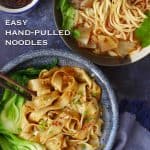
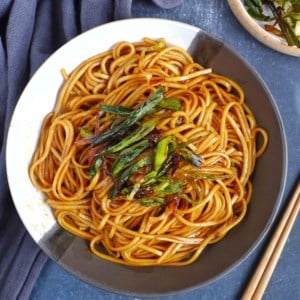


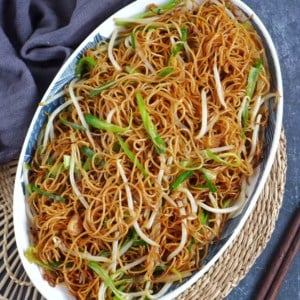
ah, yes! I remember getting “Xi An La Mien” in LiuZhou many many years ago. I loved the stuff. I’m excited to try this here in my little American home with my very American hands…. here’s to hoping I can do it!
And… can you freeze the dough? I freeze egg noodle dough regularly, so I assume you can freeze this too? Let it thaw, and then rest for the 1.5 hours, I assume. Have you tried freezing it?
I’ve never tried freezing the dough. I assume it works but I’m not 100% sure.
Happy pulling Mama Rachael!
I want to try making these but I can’t wait for the 1.5 hrs, so I plan on making the dough a day ahead. How many days can the dough stay in the fridge without getting bad?
Yes, you can but do not keep it in the fridge for more than 24 hours. And don’t forget to bring it back to room temperature before working on it.
I have tried your recipe several times and have had disappointing results each time, despite weighing the ingredients carefully and following instructions to the letter. From reading your replies to comments and checking other posts, I’ve isolated two issues: 1) our Canadian prairie all-purpose flour is too high in gluten (13.3%), and the dry winter air seems to be sucking the moisture out of the flour even before it’s weighed. I don’t have cake or pastry flour. Could I correct for the high gluten solely by adding more water and increasing the rest time? Or is there another flour I could substitute for part of the wheat flour (e.g. rice, corn, potato) to reduce the total gluten in the recipe? Thanks!
Hi Jo-Anne! I guess you’ve missed the information I’ve provided in the post about the flour choice. As I mentioned “Flour with a medium level of gluten works the best for hand-pulled noodles. That is to say that the protein content should be 10-11g per 100g flour… Flour high in gluten (above 13g protein per 100g flour) can be used for this recipe but it’s harder to work on.” My suggestion is to add a little more water to the dough and leave it to rest for longer.
I had read the info. you had posted re: flour choice, but I live in a remote location and don’t have access to other flour. Thank you very much for the feedback – I will try using more water and resting the dough longer!
My first attempt came out great. Ericellent recipe and explanations
That’s wonderful to hear Rochelle!
does hand pulled egg noodle made the same way with adding egg in to make the color yellow? Thanks.
The yellow colour of hand-pulled noodles comes from alkaline agents (such as Peng Hui or lye water) not eggs.
Thank you! Love you!
Hello Wei:
First, we really appreciate you sharing your knowledge and recipe development with all of us, and I’m sure your effort is rewarding financially as well as on a personal level. My wife and I both enjoyed Chinese cuisine when we lived in large cities with a good selection of Oriental restaurants. Now that we live out in the boonies (more or less) where the nearest authentic Oriental cuisine is about a five hours drive away, if we can’t make it here in our homes, then we don’t have it. So, thank you to you and your fellow online chefs/recipe sharers.
My second point is just to draw your attention to the fact that my wife is one of an increasingly larger number of people who are afflicted with Celiac disease. In her case, the onset didn’t happen until years after we moved from cities where Asian food was a regular in our diets.
On one level, I wonder if this disease is rare in Asian people and primarily confined to Caucasians because of lifestyle, years of diet choices, etc. Gluten is so prevalent in Asian cooking, from ingredients like noodles to condiments like soy sauce, oyster sauce, hoisin sauce, shaoxing wine, etc. that I wonder how Asians in Taiwan, China, and so on could live with the effects?
Following that, it is not unexpected that it is rare to see an author of Asian recipe websites also include gluten free recipes/ingredient alternatives for those online looking at their recipes wistfully, thinking they would love to try it – but there isn’t a gluten free alternative.
For example, any and all recipes involving noodles, as this one does, or wrappers such as those for your various versions of bao buns.
Anyways, just a thought to pass on to you, not a critical comment. Running our own business, we completely understand that you focus on your most likely market, rather than the roughly 1% of the population who are diagnosed Celiacs.
We will nevertheless continue following your pages and your efforts, because not all your recipes are off limits to Celiacs like my wife (and none are off limits to me when my wife is traveling on business).
Thanks again from both of us,
Rick
Very nice to learn your thoughts Rick! Sorry to hear that your wife is suffering from Celiac disease. I know it’s a common problem in the West. As far as I know, it’s quite rare in China, and in other Asian countries. Chinese cuisine, especially the northern style, calls for many ingredients which contain wheat. But many dishes are adaptable for gluten free diet since some key ingredients have gluten free versions, e.g. soy sauce, oyster sauce, etc. Regarding noodles, rice noodles are a great alternative. I also have a gluten free version of dumpling wrappers (see notes in my post on Steamed dumplings). For bao buns, it’s quite difficult to achieve the desire result with gluten free flour.
This worked out pretty good for me, but there were a couple parts in the instructions that I felt could use some clarifying.
1) the suggested thin noodle width of 1cm doesn’t really match up with the image, or my understanding of hand-pulled noodles. This seems like it would make fairly flat noodles, but idk if it’ll thin enough after stretching or if it was just an error, esp since the photo doesn’t match.
2) it’s suggested to cook one serving at a time, while also suggested to stretch and drop one noodle before starting the next, but ALSO SUGGESTED to cook for max one minute. I didn’t do this, because it doesn’t seem physically possible.
Thank you for trying out my recipe! I think there is some misunderstanding. Here are my answers to your questions:
1. I suggest you cut the flat DOUGH into 1cm strips (if making round noodles). This is not the measurement of the noodle width that you produce. After stretching, they’ll become much thinner (please watch my video tutorial for reference).
2. Regarding the cooking time, as I mentioned in the recipe, the first step is to stretch and drop all dough strips (for one portion) one by one. The second step is to cook them for 1 min (if making round ones). This one minute doesn’t include the time you spend stretching the noodles.
Hope this is clear!
I actually made the noodles, although strand by strand, without doubling much. Lovely recipes and excellent blog. I’m getting reacquainted with my Chinese culinary heritage. Thank you!
You’re welcome Jun! Enjoy your journey cooking delicious Chinese food!
Oh my….I tried the hand-pulled noodles for the first time 2 days ago and it was a success. Needless to say, we had a very satisfying dinner!! Thank you for your easy to understand instructions and video.
I am planning to make the green onion infused oil and a few of the sauces.
Thank you.
My pleasure to share! Hope you’ll also have enjoyable experience trying out other recipes.